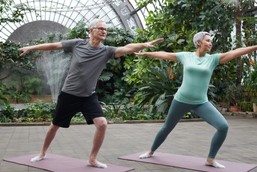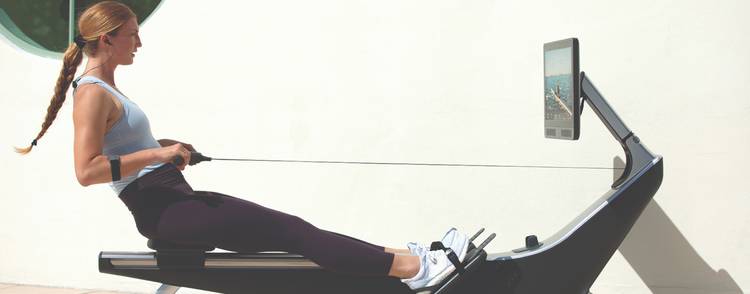
Improve Mobility & Stability From Home: 6 Balance-Boosting Exercises for Seniors
Balance and mobility are two things that we often take for granted. But without them, some of your favorite activities, like playing with grandkids or taking a walk in the park, become nearly impossible.
Research has shown that balance begins to decline in midlife, starting at the age of 50.[1] But luckily, there is a way to combat these age-related effects and continue to live a long, active, and healthy life well into your golden years. (Didn’t you hear? 80 is the new 60!)
The solution? Including balance and mobility training in your fitness routine.
In this blog, we’ll help you understand why it’s essential to maintain these functions as you age and give you 6 exercises to help you improve balance and mobility from home.
What are Balance and Mobility?
Balance is your ability to stay upright without falling over, whether you’re moving or staying still. Without balance, you would trip and stumble doing simple tasks like walking or sitting in a chair. Your muscles, joints, vision, and inner ear all play a role in maintaining your balance.
Mobility, on the other hand, is how freely you can move. It’s your ability to bend over and tie your shoes without back pain. Or take a flight of stairs without severe discomfort in your knees and ankles. Good mobility requires muscle strength, joint flexibility, and a certain amount of balance.
Balance and mobility go together like peanut butter and jelly. When you have good mobility, you move around easily. And when you have a good balance, you can do all that moving without falling over. Together, they help you live an active, pain-free lifestyle.
Why Balance and Mobility Training Matters for Older Adults
The #1 leading cause of injury-related hospitalizations and injury deaths among older Canadians is falls.[2] One of the most common causes of age falls is sarcopenia: the involuntary loss of muscle mass, strength, and function as you age.[3] Weaker muscles and joints directly impact your balance and mobility and your ability to move effectively to perform basic activities.
The good news? Regular exercise with balance and mobility training can help. A 2019 study on adults between the ages of 75-98 found that long-term strength and balance training just once a week improved or maintained strength and mobility. Researchers saw positive impacts in things like knee flexion, walking speed, and chair rise performance. Balance and mobility training is essential if you’re an older adult who wants to
- Improve joint range of motion (ROM)
- Combat the effects of age-related muscle loss
- Play at the park with your grandchildren
- Join your friends for a game of golf or tennis
- And live an overall healthier and more active lifestyle
6 Senior-Friendly Exercises to Improve Your Balance and Mobility
The key to balance training is to incorporate it into your daily routine. Some activities, like going up the stairs and tying your shoes, already challenge your balance and mobility. But if you want specific balance and mobility exercises that not only test your equilibrium but also help build strength, here are 6 designed with seniors in mind.
1. BOSU Ball Squats:
The BOSU Pro Balance Trainer is an innovative training tool that tests your balance and builds strength. It looks like an exercise ball cut in half and has two sides: 1) the inflated side and 2) the flat rubberized platform. Performing squats on either side of the BOSU adds an element of instability, further challenging your balance and core strength.
How to do BOSU Squats:
- Start by standing on the inflated side of the BOSU ball with your feet hip-width apart
- Bend your knees and push your hips back like you’re sitting in a chair. Keep your chest up and knees in line with your toes (don’t let them cave in!)
- Push through your heels with equal pressure as you stand back up
2. Step-Up with a Knee Lift:
This exercise builds strength in your quads, glutes, and hamstrings while testing your balance and coordination. And lifting your knee at the top of the movement engages your core and challenges your stability. We recommend using the Reebok Style Step for this exercise because it has a sturdy, durable platform and 3 adjustable heights that offer varying levels of difficulty.
How to do Step-Ups with a Knee Lift:
- Stand facing the Reebok Style Step
- Step up with your right foot, then lift your left knee to hip height
- Step down and repeat with the other foot. Challenge yourself with different step heights and stepping speeds.
3. Seated Twists:
Seated twists are one of the most beneficial abdominal exercises for seniors. This triple-threat exercise helps enhance your core strength, maintain your balance, and improve spinal mobility. Performing this exercise on the Fitness Town Balance Cushion not only helps to protect your tailbone but also adds an extra bit of instability to challenge your balance.
How to do Seated Twists:
- Sit on the balance cushion, knees bent, feet flat on the floor
- Hold your hands together at your chest
- Engaging your abs, twist your upper body to the right, then to the left, lightly tapping the floor with your fists between reps
4. Ladder Crossovers:
The GoFit 15′ Agility Ladder helps you improve your coordination, agility, and balance. And the “Ladder Crossover” exercise helps to boost your side-to-side (lateral) mobility, which is crucial for changing directions quickly and efficiently. This can have significant impacts on daily activities, like navigating crowded spaces or avoiding a lost Lego left on the living room floor.
How to do Ladder Crossovers:
- Place the ladder vertically. Stand to the right of the ladder, feet together
- Step your right foot into the first square, followed by your left
- Then step your right foot to the right of the ladder, followed by your left
- Repeat this ‘in, in, out, out’ pattern as you move along the ladder
- Start slow, then gradually increase your speed
5. Single-Leg Step-Down:
The single-leg step-down provides a focused challenge to each leg, which can help correct any strength imbalances while improving stability and gait. It’s also a common exercise used to treat knee pain from tendonitis. The Reebok Style Step is a great tool for the step-down because the 6, 8, and 10-inch heights allow you to start with a small step and work your way to a more challenging height.
How to do Single-Leg Step-Downs:
- Start by standing on the step with your right foot, keeping your left foot hanging slightly off the edge
- Gradually lower your left foot towards the ground by hinging at your hip and bending your knee until your toes tap, then bring it back up
- Keep your right knee directly above your ankle throughout the movement
- After a few slow and controlled reps, switch legs
6. One-Legged Balance:
Standing on one leg will test your balance. Standing on one leg while on a BOSU ball takes that to a whole new level. Taking a flamingo stance on either side of a BOSU will fire up your lower body and core while challenging your ankle mobility and overall stability.
How to do the One-Legged Balance:
- Start by placing the BOSU ball on a flat surface with the platform facing down and the rounded side up
- Place one foot in the center of the “stability ball”
- Slowly lift your other foot off the ground while keeping your body upright. Aim for holding this pose for 10 seconds and focus on keeping your core tight and hips level.
- After 10 seconds, return the lifted foot to the ground and switch legs
Balance and Mobility Training are Essential for Longevity
You can’t stop yourself from getting older. But you can take steps to stop yourself from feeling older. Whether you’re a seasoned lifter or just starting your fitness journey, incorporating balance and mobility training into your daily routine helps you shine in your golden years. For more balance and stability training tools, check out our curated collection here.
References:
[1] “Balance Begins to Decline as Early as Age 50.” UCLA Health System, www.uclahealth.org/news/balance-begins-to-decline-as-early-as-age-50#:~:text=Researchers%20have%20found%20that%20balance,study%20participants%20managed%2028%20seconds. Accessed 11 July 2023.
[2] Canada, Public Health Agency of. “Government of Canada.” Canada.Ca, 8 June 2022, www.canada.ca/en/public-health/services/publications/healthy-living/surveillance-report-falls-older-adults-canada.html.
[3] Volpi E, Nazemi R, Fujita S. Muscle tissue changes with aging. Curr Opin Clin Nutr Metab Care. 2004 Jul;7(4):405-10. doi: 10.1097/01.mco.0000134362.76653.b2. PMID: 15192443; PMCID: PMC2804956.
Blog Image: Marcus Aurelius from Pexels

